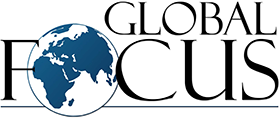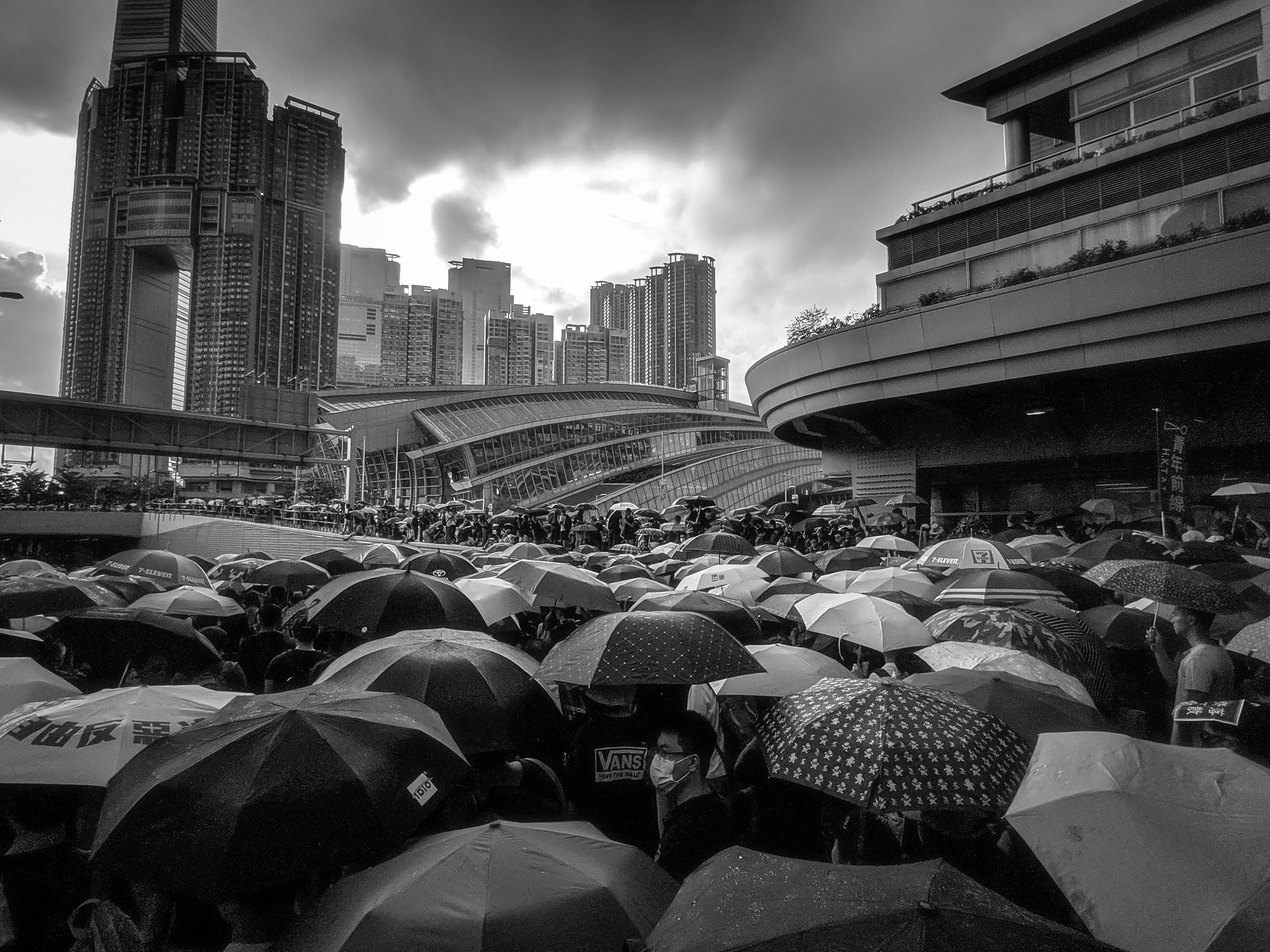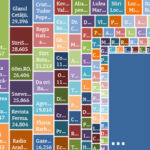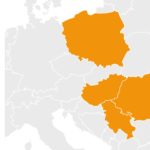By Dana Trif| Cluj Napoca & Ho Ming-sho| Taipei
Five years have passed since the 2014 Umbrella Movement and the ‘Occupy Central with Love and Peace’ civil disobedience campaigns that brought tens of thousands onto the streets of Hong Kong. Back in 2014, the protesters’ demands were focused on genuine universal suffrage for the election of the Special Administrative Region’s (HKSAR) Chief Executive (CE) and of the members of the Legislative Council, Hong Kong’s Parliament.
The political background
The Umbrella Movement took place between 28 September and 15 December 2014. During that time, for 79 days, protesters occupied major central areas in Hong Kong including the Admiralty, a district known as a financial hub as well as home to several government buildings, including the CE and Legislative Council’s offices; Causeway Bay, which includes Victoria Park, one of the locations for the recent protests; and Mongkok, among the world’s busiest shopping areas. The ‘Occupy Central with Love and Peace’ civil disobedience campaign, organized by Chan Kin-man, Benny Tai, and Reverend Chu Yiu-ming preceded the Movement by almost a year.
In an interview about democracy and Henry David Thoreau published in Revista 22 in September 2017, Chan Kin-man recalled that preparations for Occupy had started as early as 2013, when people began discussing non-violent means of protesting.
The campaign’s political goal was universal suffrage for the 2017 Chief Executive election, a right which the protesting Hongkongers claimed had been granted to them under the HKSAR’s Basic Law (BL). Fears that Beijing might interfere with this democratic process were stoked by official declarations from mainland China that although elections were supposed to be universal, the power of nominating the candidate was not.
Candidates would be first vetted by a representative Electoral Committee. This stance contradicted the demands of Occupy, which had requested the unconditional implementation of the ‘one country, two systems’ principle and had already held a referendum to support its position. Soon enough their campaign would receive political support from student activists who rallied Occupy to the bigger Umbrella Movement.
On September 22, 2014, during a high profile visit to Beijing by several Hong Kong powerbrokers, students from more than 20 universities entered the grounds of the Chinese University of Hong Kong wearing yellow ribbons and chanting pro-democracy slogans. They declared a student class boycott while demonstrating for ‘genuine democracy’ through civil disobedience. The marches on government buildings began a couple of days later, sparking the Hong Kong-wide protests that in October led to a televised debate with government negotiators led by Carrie Lam.
However, the Movement’s political goal was not achieved. The current Chief Executive and former chief negotiator with Umbrella protesters, Carrie Lam, was elected on March 25, 2017. Ms Lam is the fourth CE since the city was handed over by Great Britain to the People’s Republic of China in 1997. She was elected, following Beijing’s strict scrutiny, according to the special procedure laid out in the Basic Law.
An Election Committee, composed of 1200 members from functional groups who supposedly represent all the professions as well as politicians and the Hong Kong members of the PRC’s National Committee, is responsible for electing the Chief Executive.
While the Basic Law promises that the principle of universal suffrage (one person one vote) will eventually be realized, the Electoral Committee is still responsible for selecting the CE. Hong Kong’s Legislative Council, its de facto Parliament, has 70 members, only 40 of whom are directly elected by the population.
This is Ms. Lam’s first five-year mandate, which is set to expire in 2022. The BL is Hong Kong’s quasi-constitution acknowledging self-government in all but two areas: defense and foreign relations. Despite the PRC exercising sovereignty over the region, Hong Kong still enjoys a significant degree of autonomy. Chinese and English are both official languages of the executive, legislative and judiciary branches. The HKSAR has its own flag and issues passports for its residents.
The Basic Law is a political compromise giving an institutional shape to the ‘one country – two systems’ principle. This compromise, enshrined in the 1984 Sino-British Joint Declaration on Hong Kong and signed by the then British Prime Minister Margaret Thatcher, effectively meant that “the previous capitalist system and way of life shall remain unchanged for 50 years” (Article 6, BL).
The deadline for systemic political change in Hong Kong therefore falls in 2047. However, what will happen after this deadline is anybody’s guess, hence the growing fear especially among younger Hong Kongers that for them the future could only mean a return to the authoritarian politics of the mainland.
The protests have evolved into a campaign to reassert Hong Kong’s own identity and its unfinished project of democratisation.
This is the historical and political background against which, on June 6, 2019, a massive rally attended by at least one million people demanded the withdrawal of a seemingly innocuous extradition legislation. This huge demonstration had gathered strength in the months before, with Hong Kong’s largest rally since the Umbrella Movement taking place on April 28. Starting that day, and until this moment, the protests have continued relentlessly. The protesters’ demands have gradually grown closer to those of Umbrella.
Rather than just requesting the withdrawal of an ill-fated bill, the protests have evolved into a campaign to reassert Hong Kong’s own identity and its unfinished project of democratization. Edward Leung’s 2016 slogan – “Restore Hong Kong, revolution of our time” – has unexpectedly been embraced by the protesters as a symbol of their pro-democracy fight. Leung, 28, is an Umbrella-turned Localist Movement political activist who is currently serving a six-year prison term because of a confrontation with the police in 2016. He has been widely regarded as the spiritual inspiration for the ongoing protests.
The spark that ignited the fire
The story of Hong Kong’s renewed struggle for democracy began with a rather sordid murder case. In February last year, instead of spending a romantic Valentine’s getaway in Taipei, a young couple in their early twenties ended up embroiled in a deadly fight.
The young woman, Poon Hiu-wing, who had revealed she was pregnant with another man’s child, was strangled to death. Her boyfriend, Cha Tong-kai, 19, stuffed her body in a suitcase, which he left in the bushes close to a Taiwan subway station, and returned to Hong Kong. After the woman’s body was found, Mr. Chan admitted having murdered Poon. However, because the crime took place in Taiwan, with whom Hong Kong had no extradition treaty, Taiwan’s prosecutors were unable to process the case.
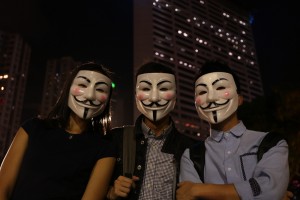
Hong Kong protesters. Photo: Shutterstock.
The victim’s family publicly demanded justice for their daughter. Carrie Lam could have chosen to sign the extradition agreement with Taiwan or handle the murder as a special case. She opted instead to broaden the bill’s scope by including extradition agreements with other states, such as mainland China.
This political move became the spark that ignited the fire. Not only did Umbrella’s universal suffrage demands fall on deaf ears, but since 2017 its leaders have been prosecuted and imprisoned. Joshua Wong, the iconic teenager identified as one of the Movement’s leaders, was released from prison in June this year.
Before his incarceration fellow activist Edward Leung was first barred from running for a seat in the Legislative Council, for not showing sufficient loyalty to Hong Kong’s status as part of China. In April, the organizers of the non-violent civil disobedience campaign ‘Occupy Central with Love and Peace’ were also sent to jail.
Chan Kin-man, a sociology professor at the Chinese University of Hong Kong, and Benny Tai, a law professor at Hong Kong University, received a 16-month term in jail. Reverend Chu Yiu-ming was given a suspended sentence on account of his old age and public service record.
Mysterious abductions of unwanted political opponents, or those perceived as such, have further eroded Hong Kongers’ trust in their institutions. In 2015, five partners of a publisher specializing in books critical of Beijing’s political elite disappeared one by one and ended up in the PRC.
Lee Bo, an editor at Mighty Current Media, later called his wife from Shenzhen, across the border in mainland China, claiming that he was assisting the authorities in an investigation. In January 2017, one of China’s best known financiers, Xiao Jianhua, with connections to the family of Xi Jinping himself, was taken away by several unidentified men from his apartment in Hong Kong’s exclusive Four Seasons hotel. Mr. Xiao was in a wheelchair, with his head wrapped up in a blanket.
Not only did Umbrella’s universal suffrage demands fall on deaf ears, but since 2017 its leaders have been prosecuted and imprisoned. Mysterious abductions of unwanted political opponents, or those perceived as such, have further eroded Hong Kongers’ trust in their institutions.
Such ominous events aside, the current wave of protests appears to some analysts as one of a kind. They are, for all accounts and purposes, leaderless. Although the Civil Human Rights Front (CHRF), a coalition of 50 organizations, including pro-democracy parties founded in 2003, is credited with masterminding some of these mass rallies, their organizational structure is mostly decentralized.
The black shirt, the protesters’ trademark apparel, has become the symbol of a collective identity and, at least one participant says, of mourning Hong Kong. Protesters have also used more assertive tactics than five years ago, from the storming of the Legislative Council building, the LEGCO, on 1 July, to the Hong Kong Airport sit-ins which began on August 9 and turned violent four days later.
One man alleged to have been a mainland-Chinese intelligence agent who had infiltrated the sit-in was later discovered and beaten. Some protesters tried to shield the man and help the paramedics carry him away. The Global Times (GT), a pro-Beijing newspaper, later identified a second man who had also been restrained and hit as a GT reporter. This episode of ‘mob violence’ was portrayed differently in the media, with pro-government Chinese news outlets denouncing the attack.
To the protesters, it was a staged event by the Chinese authorities in an attempt to smear the Hong Kongers’ campaign. They apologised for their actions the following day. A poster held by two young women read: “Dear Tourists/We’re deeply sorry about/What happened yesterday/We were desperate and/We made imperfect decisions/Please accept our apology”. The Hong Kong police was equally heavy-handed, using tear gas and rubber bullets in order to disperse the crowds as early as June 12.
The political response from Hong Kong’s Chief Executive, Carrie Lam, did not seem to address any of the protesters’ worries and demands. In two rare press conferences, on June 15 and August 13, Ms Lam announced plans to shelve but not withdraw the legislation. In what could be seen as a move to appease the crowds, in August she emphatically stressed that the “the bill [was] dead”. In the meantime, in an unprecedented step back, Lam announced on September 4 that the Bill had been withdrawn.
Carrie Lam’s approval rating has fallen below 30%, with many calling for her resignation. Analysts have been quick to notice the increasingly sharp tone of the protests and their continuing strength. Rather than diminishing in numbers, another mass rally on August 18 was attended by an estimated 1.7 million people despite torrential rain.
Through posters, the demonstrators expressed their support for a young woman heavily injured in one eye by a police-fired rubber bullet. The rally took place in Victoria Park because a prior request by CHRF for an authorised march had been rejected.
However, the protesters refused to comply with the ban. Young and elderly residents, as well as parents with children, disregarded a potential indictment for unlawful assembly, which carries a hefty five-year prison term, and marched to Hong Kong’s Central District.
To rise up fearlessly against an emerging regional hegemon is a sign of courage,
of vision and of things to come.
According to an article published by The Guardian, the crowd chanted slogans such as “Fight for Freedom!” and “Reclaim Hong Kong, revolution of our era!” Similar to some of the techniques used in the Romanian mass protests of 2017-18, the demonstrators projected laser lights onto a government building and the People’s Liberation Army garrison stationed nearby. Sit-ins, Lennon Walls in Umbrella style decorated with pro-democracy messages, scuffles with the police and well-attended mass rallies have continued to this day.
Chinese fears
Beijing’s answer to Hong Kong’s growing unrest has been rather restrained. With a carrot-and-stick strategy, the Communist Party has dug in its heels, refusing to acknowledge the legitimacy of Hong Kongers’ demands and accusing those which turned violent of foreign-backed terrorism.
It also moved behind the scenes by pushing the Beijing-friendly business community to retaliate by, for example, laying off employees who participated in the protests. Cathay Pacific Airways was forced to hand over information concerning personnel to Chinese authorities before sending them to work on mainland-bound flights. However, there is much to be feared in a prolonged confrontation with pro-democracy protesters.
Beijing’s top official responsible for Hong Kong, Zhang Xiaoming, dubbed the rallies a “colour revolution”, alluding to similar events in Eastern Europe. The specter of a new revolution challenging the Communist Party’s grip on power seems to be one of Beijing’s deep-seated worries.
How the PRC will react to the growing calls for democracy on its borders is a question many analysts have grappled with. Some point to Taiwan as the reason why the PRC could never tolerate a greater degree of autonomy for Hong Kong, let alone independence.
Such a move would jeopardise the PRC’s claims of historical reunification with the island, and boost the pro-independence camp in the Republic of China (Taiwan). Geostrategists speculate about the position of the United States and the former colonial master, Great Britain. President Trump’s praise in a tweet of Xi Jinping’s leadership qualities would suggest that U.S. diplomacy might not wish to interfere should the situation escalate further.
The latest reactions by Congress, though, including a bi-partisan draft bill to ensure that protesters are not obstructed from acquiring American visas, might prove that the President is alone in his sympathies for Xi. The Hong Kong Human Rights and Democracy Act would require the U.S.
President to identify the people connected with the abductions of Hong Kong booksellers and journalists, as well as those involved in the suppression of basic freedoms in HKSAR. Their American assets would have to be frozen and they themselves barred from entering the country.
Hong Kongers have expressed their support for the Act. On September 17, former Umbrella activists Joshua Wong and Denise Ho, a famous Hong Kong-based Cantopop singer, gave testimonies about the ongoing protests before the US Congressional-Executive Commission on China. Great Britain, on the other hand, is caught in its own domestic challenge of Brexit.
Two (irreconcilable) systems – one country
The media has drawn parallels between Hong Kong in 2019 and Tiananmen Square in 1989. Many fear a heavy backlash from mainland China, although most agree that neither Xi nor the Party could afford a heavy-handed military reaction. The latter would once again blacklist the regime and squash Hong Kong’s status as a financial and economic global hub.
The symbiotic relationship between mainland China and Hong Kong, a mutually beneficial one by some accounts, draws its strength precisely from the ‘two systems – one country’ principle. Yet the looming threat of 2047, the end date of this arrangement, seems to position the two sides on irreconcilable grounds.
Xi’s increasing authoritarianism and his apparently indefinite grip on power cannot sit well with demands for universal suffrage and the protection of civil and political rights. On the other hand, the PRC’s claim to legitimacy rests on economic rights and the Party’s success in eradicating poverty.
For Hong Kong, a long-time Asian and global financial powerhouse, such claims simply might not suffice. A population confronted with sky-rocketing real estate prices is already experiencing the downsides of the capitalist dream. Many hope that democratisation, in the sense of the popular election of the CE and all the LEGCO members, would solve their daily problems. This is also one of the reasons why the current wave of protests seems to cut across different social strata.
What happens in Hong Kong is a process of democratisation, an inexorable march towards a different political system. Will this process be stopped again? Will power calculations and geopolitical rivalry squash the Hong Kongers’ desire for democracy? Maybe. But to rise up fearlessly against an emerging regional hegemon, at the moment when the PRC is moving back to tighter societal control and stronger authoritarianism is a sign of courage, of vision and, perhaps, of things to come.
Chan Kin-man ended his last lecture at the CUHK with an image of the future that might help us understand the intractable opposition between two different political systems, but also the fact that (political) action always starts with a question: “On this long and distant road, sometimes I really feel that the road ahead is boundless and obscured, and sometimes the light is very dim. What can I do in this dark night?”
DANA S. TRIF is an affiliated researcher at the Center for International Studies, Faculty of Political, Administrative, and Communication Sciences, Babes-Bolyai University. In 2017, Dana won a Republic of China (Taiwan) Ministry of Foreign Affairs’s Fellowship at the National Chengchi University (Taipei). Her recent research interests cover protest movements in Europe and East Asia.
DR. HO MING-SHO is Professor at the National Taiwan University. He published “Working Class Formation in Taiwan” (Palgrave Macmillan, 2015) and, during his visit at the Harvard-Yenching Institute (2018-2019), he worked on his latest book: “Challenging Beijing’s Mandate of Heaven: Taiwan’s Sunflower Movement and Hong Kong’s Umbrella Movement” (Temple University Press, 2019).
